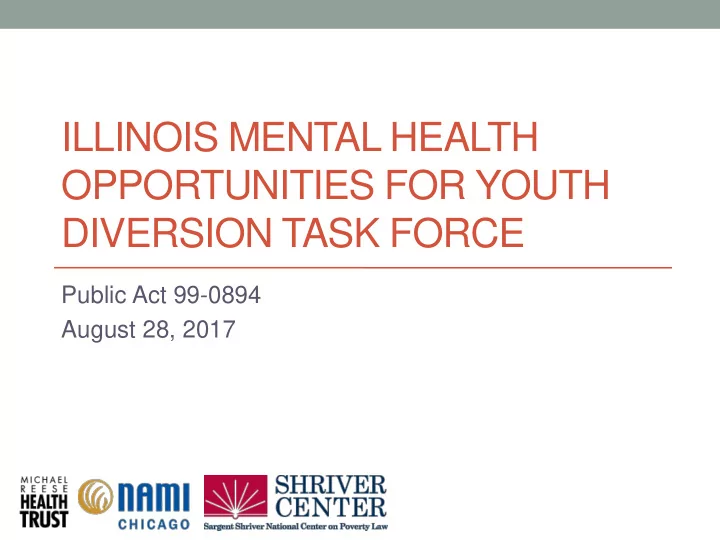

ILLINOIS MENTAL HEALTH OPPORTUNITIES FOR YOUTH DIVERSION TASK FORCE Public Act 99-0894 August 28, 2017
Agenda Topic Time 10:00 – 10:15 AM Welcome / Introductions - Minutes Approval 10:15 – 11:30 AM National Perspectives Panel 11:30 AM – 12:00 PM Information Gathering Debrief 12:00 – 12:10 PM Break 12:10 – 12:50 PM Action Team Kick-Off 12:50 – 12:55 PM Public Comments 12:55 – 1:00 PM Next Steps
Who is in the room • Name • Organization
Minutes • Approve Minutes from 7/24
Today • Provide additional information about diversion models seen as best practices on a national level • Allow for discussion and questions related to national models • Debrief on activities to this point • Kick off action teams
NATIONAL PERSPECTIVES Discussion
Patrick Gardner President of Young Minds Advocacy Project • Expert in children’s mental health law and policy. • Former Deputy Director of National Center for Youth Law, where he oversaw NCYL’s work to develop and improve juvenile mental health courts. • Served as co-counsel in class action lawsuits to improve access to mental health care for Medicaid eligible youth in Arizona, California, and Washington. • Last year, Patrick received the California Mental Health Advocates for Children and Youth’s “Advocate of the Year” award
Hon. Nan Waller Co-Chair Oregon State Court Juvenile Justice Mental Health T ask Force Presiding Judge, Multnomah County Circuit Court • Judge Nan Waller became the presiding judge for the Multnomah County Circuit Court on January 1, 2012, after serving as the chief family court judge in Multnomah County for five years. • Judge Waller has been involved in numerous collaborative efforts to improve outcomes for children and families. She chairs the Wraparound Multnomah Collaborative Council, a local initiative to address the needs of children with complex mental health issues, and has been involved in the Cross-Over Youth Practice Model. She is the statewide convener for the Casey Partnership, an initiative to safely and equitably reduce the number of children in foster care. • Currently, she also co-chairs Wraparound Multnomah, a children’s mental health initiative. • Accolades include the Chief Justice’s Juvenile Court Champion Award, and the Oregon Department of Human Services Mental Health Award for Excellence
DEBRIEF
How did we get here? • Illinois Panel • National Panel • Measures of Success
Panel Discussions • Was there an aspect of any of the models that really caught your attention? • What’s your reaction to the breadth of diversion models? • What model was the most promising practice to you in the intercept you’re interested in? • What diversion models do you think should be including in recommendations? • What common barriers were presented? • What information is missing that you need to address in your action teams?
Measures of Success • Focus the 18 and under population, while including young adults up to 25 in the conversation and making recommendations where possible. • Focus on earliest point of diversion. • Be applicable across the state, which requires broad representation and participation from throughout the State. • Consider how sectors outside of law enforcement and mental health can support diversion, including school interventions, primary care, and emergency department staff, and ensure representation in decision making includes judicial, education, and health sector representatives. • Consider how family units impact youth and mental health and consider family systems in recommendations when possible. • Identify demographic needs and differences, and consider adolescent development and social/emotional learning needs. • Identify opportunities for creating continuum of care and consider other discussions around strengthening the continuum of care for youth. • Consider how strengthen the safety net will contribute to youth diversion. • Focus on attempts to reduce recidivism for the backend intercept programs. • Consider accountability mechanisms for progress following action. • Identify opportunities to inform other processes and policies with the work done by the Task Force.
What are the common themes of this discussion that help inform moving into the action teams?
BREAK
ACTION TEAM KICKOFF
Action Teams • Community Diversion: Rebecca Levin & Sen. Donne Trotter • Law Enforcement & Initial Detention: Brandy Brixy & Rep. Deb Conroy • Court & Re-entry: Rob Vickery & Brian Conant
Goals of Action Planning • Develop an action plan to divert youth in contact with law enforcement agencies that require mental health treatment into the appropriate health care setting rather than initial or further involvement in the juvenile justice system. • Review existing and potential diversion opportunities for youth with mental health needs from the point of police contact and initial contact with the juvenile justice system • Identify funding sources for expanding diversion programs • Identify barriers to the implementation diversion models and recommend policies to address these barriers • Recommend pilot programs and policy changes based on the research conducted through the Task Force
Action Team Tools & Resources • Template • Emailed out + hard copies • Timeline • September & October • Resources • Best Practice Guide • Google Folders
Discussion • Break into groups with the following objectives: • Review action planning template and timeline • Review resource documents, discuss additional resources • Discuss missing stakeholders
Public Comments • State your name, affiliation • Comments should be no longer than 2 min
Next Steps • Meet in Action Teams • Begin developing recommendations • Come together as Task Force on Monday, November 6
Recommend
More recommend